Speech Remarks at the Australian Renminbi Forum Melbourne
Introduction
Thank you to the Australian Renminbi Working Group for the invitation to offer some remarks this morning.
Over time, the Chinese authorities have gradually opened up China's capital account. Among many other things, this has encouraged deeper financial links between Australia and China, supported by strong trade ties. There is scope for these links to deepen further. One way to see this is to look at cross-border investment in debt and equity markets. Both inflows and outflows are shown (Graph 1). For China, this measure of cross-border investment remains small relative to advanced economies and to other emerging markets in Asia.
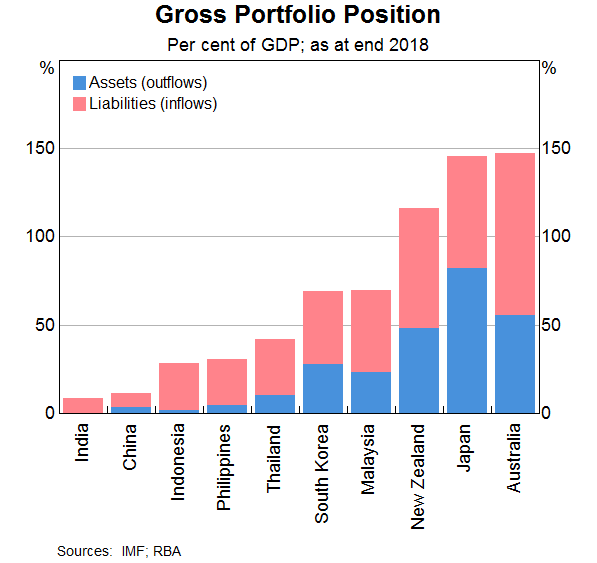
Given the focus of today's discussions, I thought it would be helpful to briefly summarise how financial links between Australia and China have evolved over the past decade or so. Increased financial connections have not only revealed themselves by way of a rise in bilateral investment but, of particular interest to this audience, we have also observed a rise in the use of the renminbi by businesses in Australia.
Growing economic ties
Australia's economic relationship with China is underpinned by strong trade ties. Australian trade with China has expanded rapidly over the past decade, to the point where China is now Australia's largest trading partner.[1] China accounts for nearly one-third of Australia's exports and around one-fifth of our imports. The rising share of Australia's exports going to China really stands out (Graph 2). As is well known, this increase in Australian exports has been driven by China's demand for natural resources that Australia possesses in relative abundance and, increasingly, for tourism and education services.
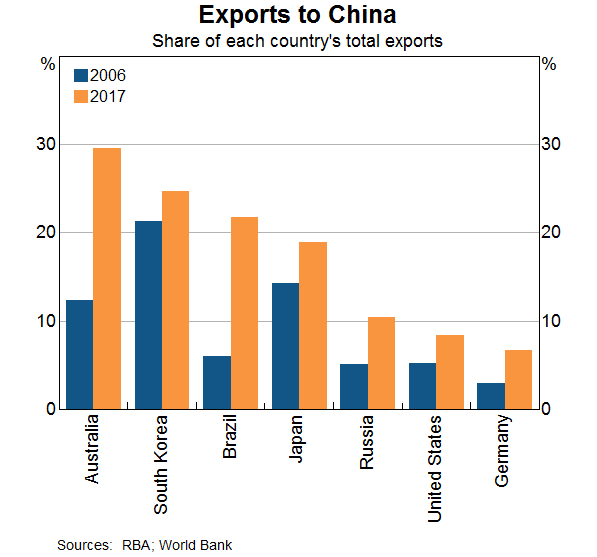
These growing economic ties have also been reflected in deepening financial integration.
Chinese investment in Australia
While the financial links with China are still in their formative stages, one financial link that has received considerable attention in recent years is Chinese investment in Australia. This has largely been driven by two factors.
First, there has been the gradual opening of China's capital account by the Chinese authorities. This has led to an increase in outbound investment from China. For more than a decade, Australia has been a significant destination for this investment both in absolute terms and relative to the size of Australia's economy. Since 2005, annual Chinese direct investment in Australia has averaged 0.7 per cent of Australian GDP. Comparable figures for the United States, Japan and Germany are less than 0.1 per cent of their respective GDPs.
Second, there was the mining investment boom in Australia, which peaked in 2012/13. This, too, had Chinese origins, as the rapid industrialisation and urbanisation of the Chinese economy underpinned the strong rise in demand for commodities and increases in commodity prices. Chinese investment played a role in expanding Australia's capacity to meet growing demand for these commodities.
As a result of these developments, the stock of Chinese investment in Australia is about 8 times larger than it was a decade ago, although this is from a low base and still represents only about 2 per cent of the total stock of foreign investment in Australia (Graph 3).[2]
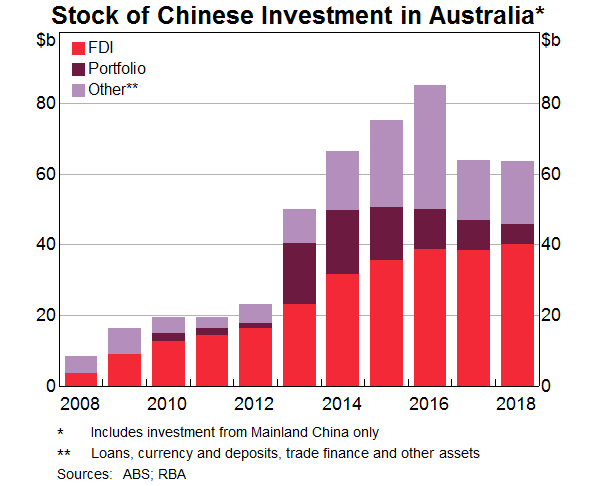
In Australia and overseas, Chinese investment has mostly taken the form of foreign direct investment (FDI). Portfolio investment has been limited, in part because the Chinese authorities apply tighter restrictions on portfolio flows. Unsurprisingly, during the mining investment boom, the majority of Chinese FDI in Australia was in the metals and minerals sector (Graph 4). These flows eased as mining investment wound down. Then Chinese investment shifted towards a broader range of sectors, particularly real estate and infrastructure projects. Since 2017, the Chinese authorities have limited outbound investment in certain sectors, such as real estate and tourism, which has had some effect on Chinese investment in Australia of late.[3]
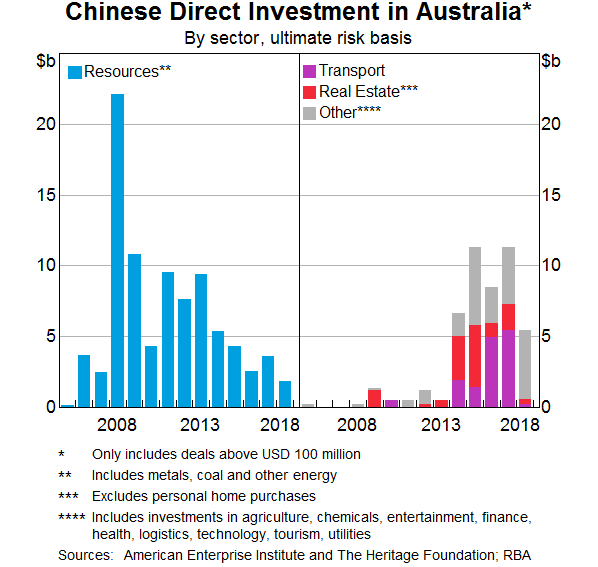
Finally, it is worth noting that large Chinese banks have expanded their Australian operations through local branches over the past decade. Lending by Chinese banks to businesses in Australia has grown from almost nothing in 2006 to around $35 billion in 2019. While this represents only 3.6 per cent of total business credit, Chinese bank credit to businesses is now larger than that provided by North American banks and of a comparable order of magnitude to business credit provided by Japanese banks and by European banks. In other words, Chinese banks are now an important source of financing for many businesses in Australia, including, of course, Chinese companies with operations here.
Australian investment in China
A feature of Australia's relationship with China that has received considerably less attention is Australia's investment in Mainland China. This has also increased significantly over the past decade. The value of those holdings is now around $75 billion or 4 per cent of Australian GDP (Graph 5). If we include Hong Kong, this number is larger still. The growth of Australian investment in Mainland China has reflected an increase in loans and deposits of Australian banks and also purchases of Chinese bonds and equities by Australian investors. Notably, the stock of portfolio investment is greater than the stock of FDI.
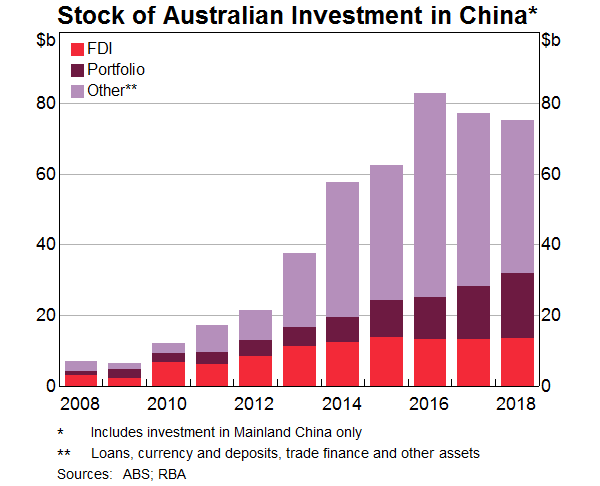
The increase in Australian portfolio investment in China reflects, in part, the greater access of foreign investors to Chinese bond and equity markets, which the Chinese authorities have been actively encouraging. Despite the significant size of China's onshore capital markets, foreigners own only around 2–3 per cent of these securities. One area the authorities have been focused on in recent years has been enhancing China's Stock Connect and Bond Connect programs, which have enabled foreign investors to access Chinese onshore bonds and equities through brokers and clearing facilities in Hong Kong.[4] Following the growth of these programs, major index providers have announced that they will increase the weight of China's onshore equities and bonds in their benchmark indices. These indices are tracked by fund managers. Hence, these changes are likely to support further inflows into China's onshore market, including from Australian investors.
RMB internationalisation
I also want to discuss the financial link that stems from the growing role of the RMB in the global financial system. Much has been said on the topic of RMB internationalisation – including by the RBA Governor at the RMB Global Cities Dialogue in 2017. Today, I want to outline briefly what this has meant for businesses operating in Australia in practice.
Growing trade ties with China have contributed to a steady increase in the use of the RMB as an invoicing currency in trade (Graph 6).[5] This has provided benefits for both Chinese and Australian businesses. It has enabled Chinese businesses to manage exchange rate risks, while providing the opportunity for Australian exporters with expenditures in RMB to naturally hedge their exposures. For example, a mining company that exports commodities to China and also imports equipment from China would have an incentive to settle some of its trade in RMB. Accommodating the preferences of Chinese customers and suppliers may have also helped Australian businesses to improve their trading relationships.[6]
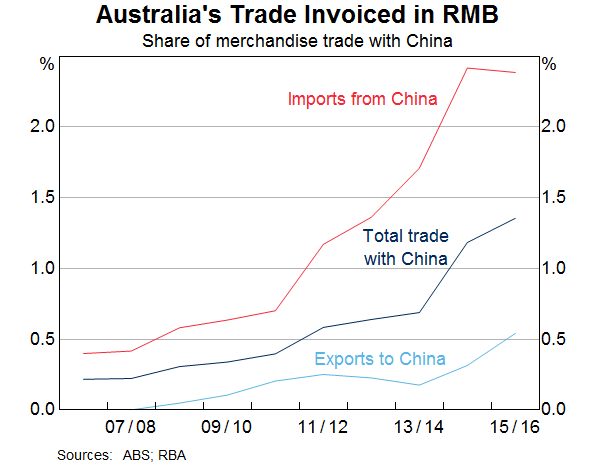
In line with the increasing share of trade invoiced in RMB, a local RMB market has been developing. In 2014, the Bank of China was appointed an official RMB clearing bank for Australia, enabling it to provide RMB liquidity in the Australian market. As well as making it easier for businesses to settle trade in RMB, it has promoted the development of a local pool of RMB deposits. The value of RMB deposits held in Australia is now around $8 billion.
The growing role of the RMB has also extended to the RBA's operations. For instance, since 2013, the Reserve Bank has held around 5 per cent of its foreign exchange reserves in high quality short-term RMB assets. As well as recognising the deepening financial and economic relationship between Australia and China, the inclusion of RMB assets has enabled the RBA to diversify its investments, enhance returns over the long run and build understanding of China's growing financial markets.[7]
Conclusion
In conclusion, while the trading relationship between Australia and China has historically attracted much attention, the financial links between Australia and China have also deepened over the course of the past decade. These connections are likely to continue to grow for a number of reasons, including the further gradual opening up of China's capital account. In turn, this opening will provide additional opportunities for both Australian and Chinese businesses, whether as a source of new capital or as destination for new investment flows.
Thank you.
Endnotes
I thank David Lancaster and Max Wakefield for invaluable assistance in preparing these remarks. [*]
Lowe P (2018), ‘Australia’s Deepening Economic Relationship with China: Opportunities and Risks', Speech at the Australia-China Relations Institute, Sydney, 23 May. [1]
These figures are calculated based on the immediate location of the investor. In practice, investment from Mainland China can flow through other economies, especially Hong Kong. See RBA (2017), ‘Box B: Chinese Direct Investment in Australia’, RBA Statement on Monetary Policy, November. Also, McCowage M (2018), ‘Trends in China’s Capital Account', RBA Bulletin, June. [2]
McCowage M (2018), ‘Trends in China’s Capital Account', RBA Bulletin, June. Also, Kearns J (2017), ‘Australian Property – Financial Stability and Foreign Involvement’, Speech at the Aus-China Property Developers, Investors & Financiers Event, Sydney, 20 November. [3]
Stock Connect and Bond Connect also allow Mainland Chinese investors to access securities in Hong Kong through their brokers and clearing facilities in Mainland China. [4]
Windsor C and D Halperin (2018), ‘RMB Internationalisation: Where to Next?’ RBA Bulletin, September. [5]
See Eichengreen B, K Walsh and G Weir (2014), ‘Internationalisation of the Renminbi: Pathways, Implications and Opportunities’, Centre for International Finance and Regulation Research Report, March. [6]
See Lowe P (2013), ‘The Journey of Financial Reform’, Address to the Australian Chamber of Commerce in Shanghai, 24 April. Also, RBA (Reserve Bank of Australia) (2013), Annual Report.[7]
